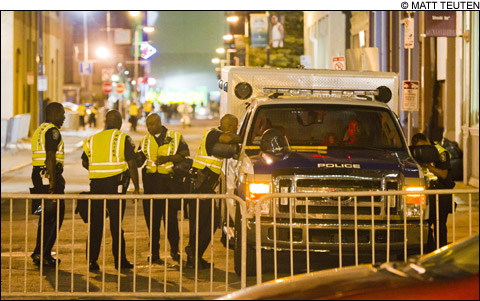
SAFE, NOT SORRY: After championship-related tragedies in 2004 and 2008, Boston police took no chances during the Celtics' recent NBA Finals run. Popular gathering spots near Kenmore Square, the TD Garden, and Faneuil Hall were locked down, and trouble was largely avoided.
|
On the morning that the Celtics and the Lakers readied for Game 7 of the 2010 NBA Finals, framing one of the most storied and intense rivalries in pro sports, the police departments of Boston and Los Angeles geared up for the worst. It's a grim modern reality: win or lose, cities with exceptional teams have come to expect the potential for arson, fan violence, and rampant mayhem.
Boston absorbed two costly expenses on the day of the decisive contest. In the morning, it paid a $3 million settlement to the family of a man who died while in police custody after having been arrested in the controlled fan celebrations that erupted near Fenway Park following the Celtics' 2008 championship. (In that case, a BPD-commissioned report found that "there was a failure by supervisory personnel to control and manage the arrest scene.") The timing of the settlement could not have been lost on the police department, as the BPD was sending into duty every active cop on the force — plus at least 100 state troopers and a smattering of officers from surrounding jurisdictions. All of them gathering, of course, for what everyone hoped — and did not hope — would be a replay of 2008.
By night's end, one city would have its hopes dashed and yet remain, on the whole, calm. Thousands of its police batons would go unswung. As its inebriated fans stumbled out of pubs, its paddy wagons would go unfilled, its handcuffs unclicked, its tear-gas canisters undetonated. In this city, there would be not a single police-issued beat-down — unless you counted the hit on taxpayers, who footed the bill for police overtime.
The other metropolis would be victorious, and their cars would cook in the street.
So what phenomenon causes fans in one city to pursue self-destruction in triumph, while the other goes, with relative civility, into the dark night of defeat? And, given a city that has won — and lost — more big games per capita than perhaps any other in America, why haven't there been more sports riots in Boston?
The birth of fandemonium
When it comes to major modern sports calamities, fandemonium as we now know it can be traced to two standout incidents. One, notoriously known as 10-Cent Beer Night, broke out at Cleveland Municipal Stadium in June of 1974, on a disastrous evening in which fans could purchase up to 60 cents worth of Stroh's at a time. As legend has it, in the second inning, a busty and polluted woman hopped the first-base wall, flashed her goods, and attempted to tongue the umpire. Soon after, the game devolved into a series of sporadic pitches between streakers, with security guards chasing platoons of naked numbnuts through the outfield. Fearing a teammate was about to be jumped, the visiting Texas Rangers stormed out of the dugout armed with bats, were surrounded by an angry mob, and had to be rescued by the Indians. By the time officials pulled the plug, fans were hurling everything from metal seats to discount beers, and both teams considered themselves lucky to have made it to the locker rooms alive.